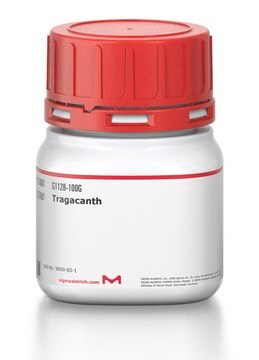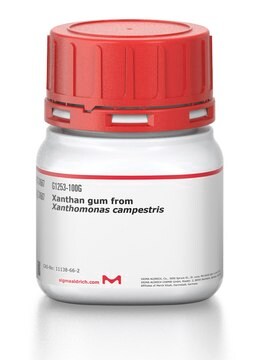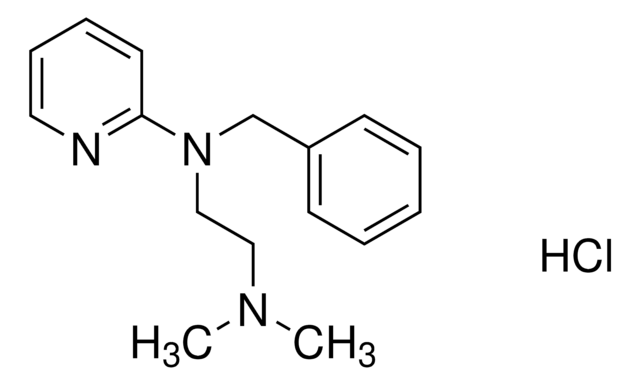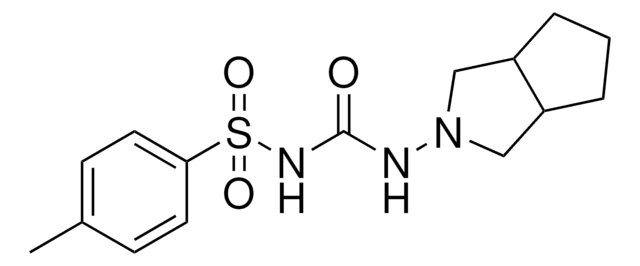G9752
Gum arabic from acacia tree
branched polysaccharide
Synonim(y):
Acacia gum
Zaloguj sięWyświetlanie cen organizacyjnych i kontraktowych
About This Item
Polecane produkty
pochodzenie biologiczne
plant (Acacia)
Postać
powder
kolor
white to faint beige
temp. przechowywania
room temp
Szukasz podobnych produktów? Odwiedź Przewodnik dotyczący porównywania produktów
Opis ogólny
Gum arabic from acacia tree is extracted from the branches of Acacia senegal and Acacia seyal trees. It is an edible dried gummy exudate. Gum Arabic has high solubility and is used in food industry as a stabilizer, emulsifier, flavouring agent, thickener and surface-finishing agent. It initiates turbidity or hinders sugar crystallization. Gum arabic inhibits color pigmentation and protein precipitation in wine production.
Zastosowanie
Gum arabic from acacia tree has been used:
- as an emulsifying agent to determine lipase activity in shrimps
- for the visualization of mossy fiber sprouting
- as an immunogen and for coating microtitre wells in plate-trapped antigen ELISAs (PTA-ELISAs)
- for silver enhancement for immunohistochemistry
- as a component for Timm′s staining solution
- in nitrocellulose-based soil adhesion assay
- to separate few-layer graphene (FLG) from bulk graphite layers
Inne uwagi
Believed to be a branched polymer of galactose, rhamnose, arabinose, and glucuronic acid as the calcium, magnesium, and potassium salts with a mol. wt. of approx. 250,000.
To gain a comprehensive understanding of our extensive range of Polysaccharides for your research, we encourage you to visit our Carbohydrates Category page.
This page may contain text that has been machine translated.
Kod klasy składowania
11 - Combustible Solids
Klasa zagrożenia wodnego (WGK)
WGK 3
Temperatura zapłonu (°F)
Not applicable
Temperatura zapłonu (°C)
Not applicable
Środki ochrony indywidualnej
dust mask type N95 (US), Eyeshields, Gloves
Certyfikaty analizy (CoA)
Poszukaj Certyfikaty analizy (CoA), wpisując numer partii/serii produktów. Numery serii i partii można znaleźć na etykiecie produktu po słowach „seria” lub „partia”.
Masz już ten produkt?
Dokumenty związane z niedawno zakupionymi produktami zostały zamieszczone w Bibliotece dokumentów.
The use of electron microscopic immunocytochemistry with silver-enhanced 1.4-nm gold particles to localize GAD in the cerebellar nuclei.
GilerovitchHG, et al.
The Journal of Histochemistry and Cytochemistry, 43(3), 337-343 (1995)
Dimensionality effects of carbon-based thermal additives for microporous adsorbents
Yang S, et al.
Materials & Design, 85, 520-526 (2015)
Monoclonal antibodies that differentiate between gum arabic, gum seyal and combretum gum
Dewey FM, et al.
Food and agricultural immunology, 9(2), 123-134 (1997)
Xenograft of human umbilical mesenchymal stem cells from Wharton?s jelly as a potential therapy for rat pilocarpine-induced epilepsy
Huang P, et al.
Brain, behavior, and immunity, 54(3), 45-58 (2016)
A quantitative method for the high throughput screening for the soil adhesion properties of plant and microbial polysaccharides and exudates
Akhtar J, et al.
Plant and Soil, 1-9 (2018)
Nasz zespół naukowców ma doświadczenie we wszystkich obszarach badań, w tym w naukach przyrodniczych, materiałoznawstwie, syntezie chemicznej, chromatografii, analityce i wielu innych dziedzinach.
Skontaktuj się z zespołem ds. pomocy technicznej







